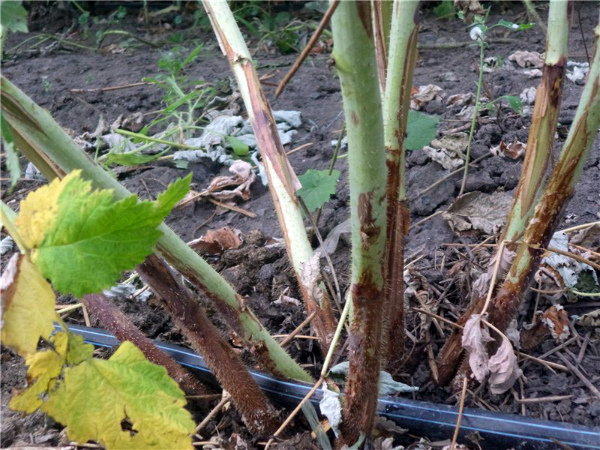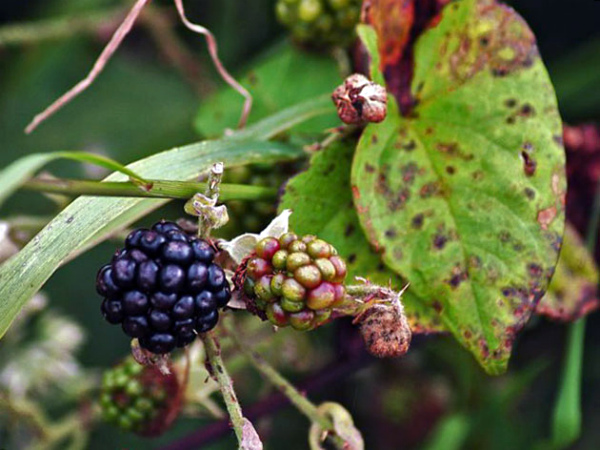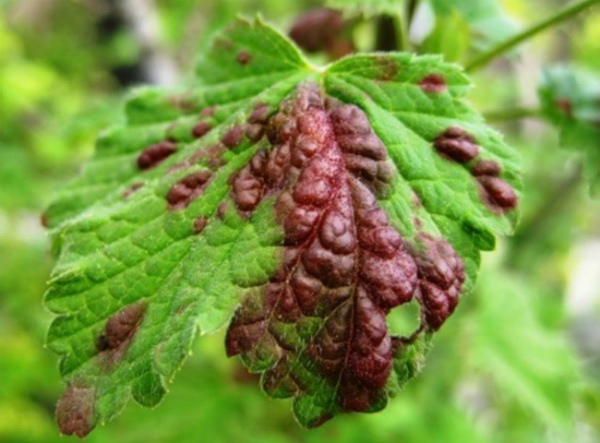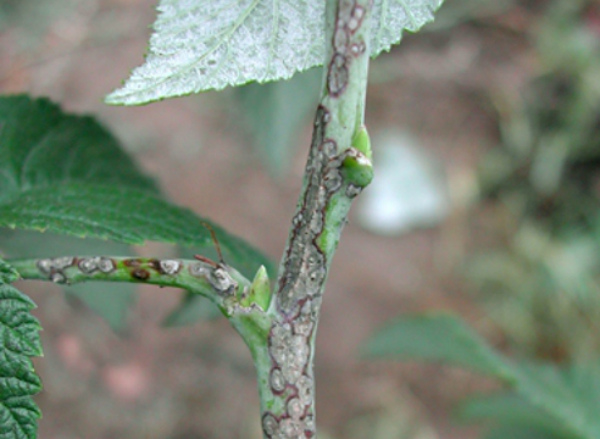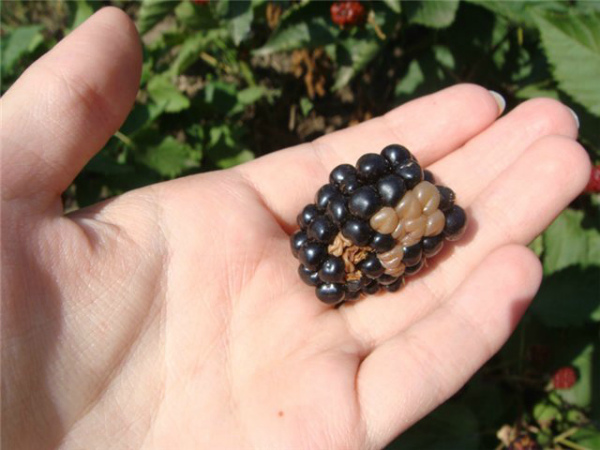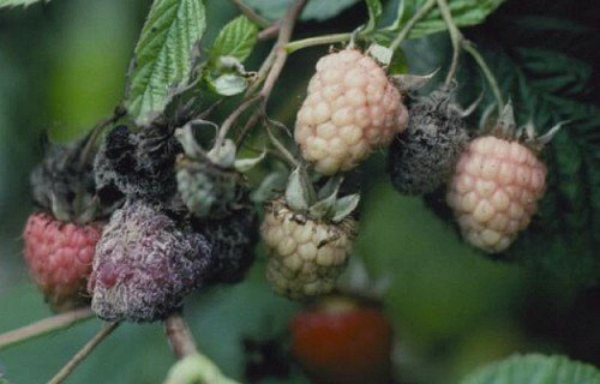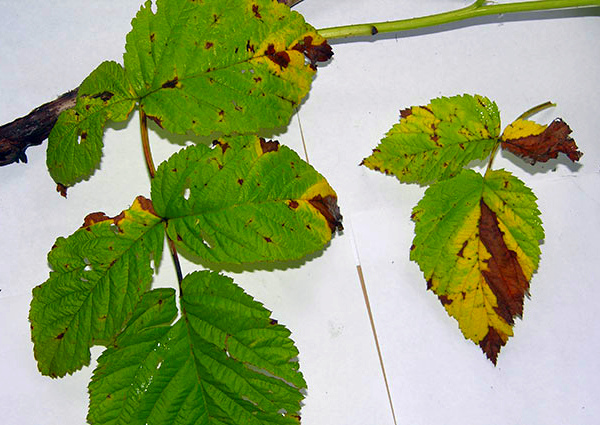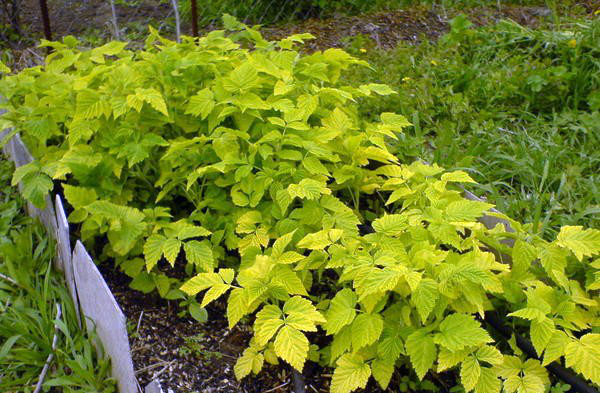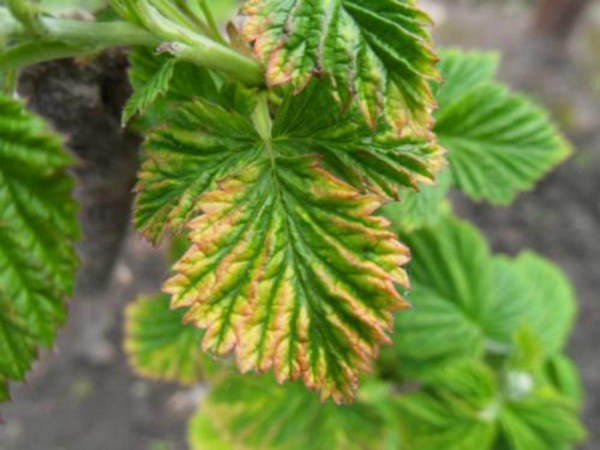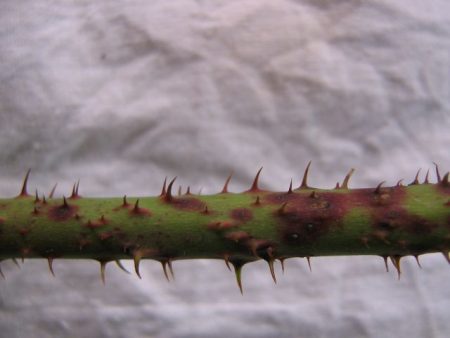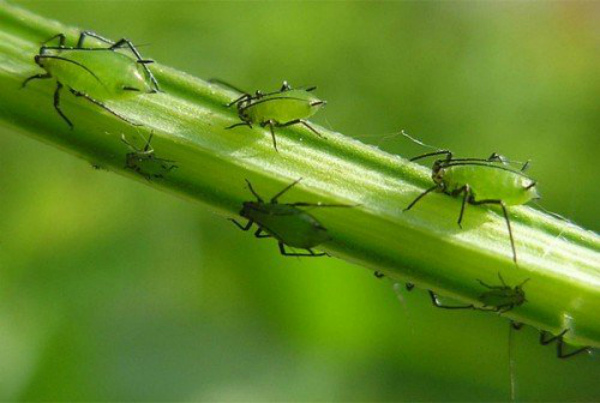Diseases of blackberries and the fight against them in the garden
Content
Infectious fungal diseases
It should be noted that infectious diseases, that is, those caused by bacteria, viruses or fungi, equally threaten blackberries and raspberries. If both of these related crops grow on the site, then they may have the same diseases, which means that therapeutic and preventive measures will have to be extended to all plants.
Most often, blackberries (like raspberries) are exposed to fungal diseases. Spores are easily carried by the wind or on the paws of insects, overwinter on plant debris or in the upper soil level. They usually affect weakened plants with impaired immunity. It so happens that the infection began, but did not fully manifest itself due to the strength and health of the plant, and the next year it will be much worse. This is one of the reasons for the mandatory destruction of fruiting shoots, they are recommended not only to be cut out, but burned so as not to give the disease a single chance. Many modern varieties and hybrids have resistance to fungal diseases, but it does not provide one hundred percent protection, so it is better to know the most important thing about common diseases in order to try to prevent them or recognize them in time.
Septoria or white spot can get on a clean area with planting material, and then it spreads very quickly. At the end of rainy May, round light brown spots appear on the leaves, which gradually turn white, after a while black dots appear in the middle of the white spots with a brown border, they gradually merge, the entire affected surface turns brown and falls out. First, the leaves on the shoots of the second year are affected, and then on the young ones. If you do not stop the process, then it will reach its maximum during the ripening of the fruits, and all plants will suffer until autumn. The berries will rot, the young leaves, twigs, shoots seem to be covered with mucus.
Stems are affected in the fall, and symptoms may not be seen in the first year of shoot growth. Light spots appear on the lower part of the shoots, which are almost invisible on green shoots; they can be noticed on differently colored branches. They can appear near the kidneys, on internodes, it is difficult to notice them until black dots appear, then cracks. The bark on the affected areas peels off, curls. The bush suffers, but grows: the affected buds die, and if the shoot is affected, then a short, weak twig develops from the nearest bud.
High humidity, shade, thickening of the bush - these are conditions favorable for the development of septoria. They also contribute to the appearance of another fungal disease specific to blackberries and raspberries - anthracnose.
At the end of May and the very beginning of June, small purple spots appear on the root suckers, young shoots of replacement from below, which then merge, turning into grayish with red ulcers, in the middle of which the tissue cracks. The bark around the ulcers begins to flake off.On the leaves, spots are located along the veins or edges, the affected tissue dries up and falls off. On brushes with fruits, these spots form a closed ring, the entire brush withers, not a single fruit ripens. On ripe fruits, gray ulcers form.
If the disease is not stopped, then the tops of young shoots will be covered with a thick crust. Such shoots can die in winter due to severe weakening, and if they survive the cold, then the yield will be minimal, since fruit buds almost did not form during the illness. And the mushroom will bear fruit - small black dots will appear on the crusts, this is its fruit. They overwinter on the affected branches, on plant debris, on weeds, and in the spring they will occupy an even larger area. Therefore, the fight must begin immediately, when the slightest signs of defeat appear.
Resistance to such diseases is shown by healthy bushes, and for good growth and health they need to be fertilized on time. Therefore, experts recommend applying a complex mineral fertilizer in the spring so that 1 sq. m produced 9 g of nitrogen, potassium and phosphorus. In the fall or spring, you need to give the blackberry humus and compost, at least 3 kg for each bush. It is necessary to monitor the cleanliness of the land around the bushes - remove the weeds on time, completely remove the leaves in the fall, burn the shoots, even if no fungal infections have been noticed. All land between and around the bushes should be well dug. And in the spring, after the first loosening under the bushes, it is useful to mulch the ground with a thick layer (7 - 8 cm) of straw with manure or peat. And when buying new seedlings, you need to inspect them very carefully so as not to bring affected specimens to the site.
Another blackberry lover is the phragmidium ruby mushroom, which induces a disease known as rust. This fungus produces different types of spores at each of its five stages of development. All stages affect the plant in different ways, and spores increasingly infect it and the surrounding plants.
First, small light brown or orange specks appear on the leaves at the beginning of summer, spores ripen inside them, which cover the stems, leaves, petioles with a sticky mass. Then this mass dries up, over time turns into a film, and the leaves, petioles and stems are covered with convex orange pads, in which the next spores ripen. Then the affected stems turn brown, orange ulcers appear on them. The mushrooms survive the winter well and continue to harvest the plant the next year. Spreading further along the stems, it causes them to dry out.
In the middle of summer, new spores fly out of the orange pads on the underside of the leaf and continue to infect the blackberry. Closer to autumn, the leaves are covered with black pustules, these are regular spores, they settle on fallen leaves to survive the winter, and from spring everything repeats again, but with greater force, young strong shoots are affected.
To protect the plants, they need to be carefully examined, and at the very first manifestations of infection - urgently take measures to disinfect. Garlic infusion shows a good result in the fight against fungal diseases. Take 300 g of garlic, chop, pour 3 liters of water, insist for a day. Then the strained infusion is diluted with warm water (twenty times) and the bushes are treated with it, preferably in the afternoon. The same product can protect against pests - ticks and aphids.
You can treat the entire ground part of the plant with milkweed infusion, you just have to rub all the shoots, leaves and stems with a small brush or a brush. For this product, milk greens (300 g) are crushed, left for a while under the sun, then poured with a liter of water, insisted for 5 hours, filtered. This treatment must be repeated every other day. It will take no more than four treatments for the plant to fully recover.
Treatment of plants with sulfur is excellent against fungal infections.But it can be carried out if the air temperature does not drop below +18 degrees, otherwise there will be no result. For 10 liters of water, you need to take 100 or 150 g of colloidal sulfur.
For prophylaxis in the spring, when the leaves are just blooming and in the fall after harvest, you can spray the bushes with Bordeaux liquid. But only it should be neutral or slightly alkaline, acidic threatens to burn the leaves. You can check the prepared liquid with litmus paper - a red color should not appear on it after contact with the liquid. Some gardeners find it better to use Burgundy liquid because it doesn't contain lime. To prepare it, take 10 liters of water, 100 g of copper sulfate and 50 g of soda ash. Sugar is also added so that the liquid sticks to the greens. Before using any drug, you need to make a test on one branch.
Didymella or purple spot affects the leaves less than the petioles, shoots, and buds. First, purple-brown spots appear on the stems, then they grow, they encircle the shoot in a ring. This leads to drying and fragility of the petioles, leaf fall, the buds do not develop, they turn black, and the stems can dry out if severely damaged. Flowers and berries are not affected, but the fruits grow weak, small, sour, may not ripen. This is also a fungal disease, it occurs with high humidity on too dense bushes. Prevention - the fight against thickening, destruction of fallen leaves, cleanliness in the aisles. You can also treat it by spraying with garlic tincture, Bordeaux or Burgundy liquid.
Powdery mildew and botrytis or gray mold attack the berries. Powdery mildew covers the berries with a white bloom, can affect shoots, more precisely, the very points of growth, young leaves. Such berries cannot be eaten, all affected parts of the plant must be destroyed. Botrytis causes berries to rot during storage. Berries affected by it also cannot be eaten, they are not suitable for processing. It can damage shoots by settling in internodes; shoots infected with it usually freeze out in winter. Placing shoots on trellises, without thickening, with the possibility of constant ventilation, will reduce the possibility of disease to a minimum. If it could not be avoided, then the means of treatment and prevention of all fungal diseases are the same as in the fight against rust.
Video "Viral diseases of blackberries and raspberries"
If viral diseases have come to planting blackberries and raspberries, they must be fought. An expert will tell you how to proceed in this video.
Non-communicable diseases
Non-infectious diseases are usually called the reaction of plants to an excess or deficiency of certain micro- and macroelements, because imbalance in nutrition often causes leaves and shoots to dry out, and does not allow fruits to ripen normally.
For example, an insufficient amount of nitrogen in the soil weakens the growth of the plant, its green parts turn pale, turn yellow, the leaves can simply fall off in the middle of summer. Such a plant blooms weakly, the fruits grow small, may not ripen, young shoots hardly develop. And an excess of nitrogen leads to the appearance of brown spots on the leaves, to their coagulation and premature fall.
The appearance of a dark brown border along the edge of the leaves indicates a lack of potassium. The leaves curl, because parts of the leaf plate grow unevenly, they can lose green, become too pale or bluish. The berries also ripen unevenly, their center may become too soft. If there is too much potassium, then the shoots grow slowly, the internodes lengthen, dark spots of dying tissues appear on the brightening leaves, the leaves fall off.
Lack of phosphorus slows down the growth of blackberry leaves, their color changes from dark green to reddish-bronze and black when dry. Leaves fall off, flowering and fruit ripening is postponed in time and slows down.But an excess of phosphorus makes the leaves brighten and discolor from the middle, and at the edges they acquire a brownish border.
If there is little calcium, then young leaves grow more and more pale, and the old ones retain their healthy rich green color. The apical buds do not develop, the upper parts of young shoots often dry up, and the ovaries decompose. Too much of this element, as it were, does not allow the shoots to grow - internodes come closer, leaves gather in rosettes, the leaf tissue between the veins changes color, sometimes it is filled with water.
With a lack of iron, chlorosis of the leaves occurs - the entire space of the leaf plate between the veins brightens, as if fading. At the same time, the berries dry out, shrink. An excess of iron leads to similar results: young leaves are completely discolored, and the berries dry out.
The lack of magnesium stains the leaf plate between the veins in red, against which the green stripes of the veins look very elegant, then they also turn red, and the leaves fall off, starting from the lowest ones. Actually, we admire this process in the fall, but in the middle of summer it testifies to the magnesium hunger of the plant. If the leaves darken, stretch out, breaking the proportions, and then curl up and fall off, then there is too much magnesium.
When a beautiful pattern appears on the upper young leaves, between the green veins the plate first turns yellow and then turns brown, then the leaf falls, then the blackberry clearly lacks manganese. If there is too much manganese, then the sheet becomes covered with spots, bends, wrinkles.
Excess and deficiency of basic nutrients are equally harmful to the growth of blackberries, it is best to try to maintain the right balance. This is possible if you carefully observe all the changes that occur during the growing season, then you can notice and correct the situation in time.
Blackberry pests
Blackberries growing in the garden can be attacked by various pests, most often insects, which can harm all parts of the plant. But this is not necessary at all. The gardener's knowledge of the main enemies can help to avoid meeting the blackberry with them.
In the upper layer of the soil, in humid lowlands, the bear lives and reproduces - a large winged insect that is perfectly adapted to dig the ground in order to lay eggs in it. Large larvae become adults only next summer, and all this time they spoil the roots of shrubs, vegetables, root crops growing on the site - everything that can be profitable. Summer residents fight the bears cruelly and mercilessly, otherwise you can lose the entire crop and all the plants on the site. They are collected by arranging traps, poisoned, bait with match heads in the traps, in the fall they are lured into pits with manure. All these activities are quite capable of driving away pests.
Khrushches also pose a considerable danger to the roots, young May beetle larvae gnaw thin roots, and adults are able to bite off the rhizomes of the stems, thereby destroying the entire bush. And they live among the roots of our plants for 5 years before turning into a pupa, then only after 1.5 years the beetle flies out. If the May beetles have settled on the site, then you need to collect the larvae. To do this, the bush must be completely dug up, shaken off all the soil from the roots on the litter, and then sift it, selecting all the larvae. Before planting the bush back, its roots and the ground in the pit are watered with a tobacco solution (100 g of tobacco dust is taken for 10 liters of water). You can dip the roots into a clay mash, adding tobacco dust to it.
Raspberry shoot aphids, raspberry nut-making, raspberry shoot gall midge, which is also called a raspberry mosquito, are capable of damaging blackberry shoots. All these pests settle on their own, lay eggs and add larvae in (or on) young blackberry shoots. The affected branches must be ruthlessly cut and burned, otherwise the parasites will destroy the entire plant.Treatment with tobacco or garlic infusion works well. Many gardeners treat bushes with hot water in early spring before buds wake up. This is a very good method of struggle, but not all plants are able to easily endure such a shower themselves. If you decide to apply it, then first you need to try on a couple of shoots, then see how they perceive it, whether the buds will not suffer.
The leaves are often affected by aphids, mites, and the raspberry leaf sawfly. Bushes are saved from aphids with infusions of garlic or tobacco, a more effective drug is nitrafen. For ticks, infusions of tobacco, garlic, onion peels are used, adding liquid soap to them. If the temperature has risen above +18 degrees, it can be treated with sulfur, if herbal preparations have not helped. Against the leaf sawfly, a solution of carbolic soap is also used.
Raspberry bud dust and raspberry-strawberry weevil are capable of destroying fruit buds, inflorescences and ovaries. They are collected mechanically, washed off with herbal preparations, in the most extreme case, you can use karbofos.
In order to prevent pests from blackberries, it is necessary to monitor the cleanliness between the bushes and in the upper layer of the soil - remove plant residues, dig up and loosen the soil, destroy infected leaves and shoots, mulch the ground under the bushes.
Video "Pests of blackberries and raspberries"
This video is about what blackberry diseases are and how to protect the crop and save berry bushes from pests without the use of chemicals.

